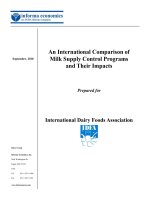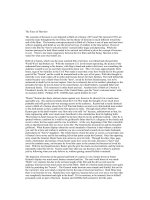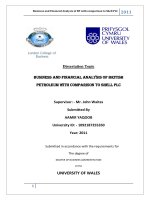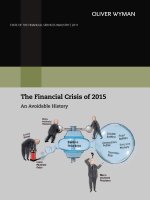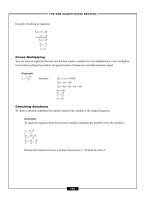Financial Constraints,Uses of Funds An International Comparison
Bạn đang xem bản rút gọn của tài liệu. Xem và tải ngay bản đầy đủ của tài liệu tại đây (2.1 MB, 54 trang )
\/PS
POLICY
RESEARCH
WORKING
Financial Constraints,
Uses of Funds,
and Firm Growth
PAPER
VI41
1671
The findingssuggest that
acrossvery different financial
systems,financial markets and
intermediarieshavea
comparativeadvantagein
funding short-term
An International Comparison
investment. An active,though
not necessarilylarge, stock
market and high scoreson an
Asli Demirgu,c-Kunt
index of respectfor legal
Vojislav Maksimovic
with
normsare associated
faster than predicted rates of
firm growth. Government
subsidiesto industry do not
increasethe proportion of
firms growing faster than
predicted.
The World Bank
PolicyResearchDepartment
Finance and PrivateSector DevelopmentDivision
October 1996
| POLICYRESEARCHWORKINGPAPER1671
Summary findings
Demirgiiu-Kunt and Maksimovic focus on two issues.
First, they examine whether firms in different countries
finance long-term and short-term investment similarly.
Second, they investigate whether differences in financial
systems and legal institutions across countries are
reflected in the ability of firms to grow faster than they
might have by relying on their internal resources or
short-term borrowing.
Across their sample, they find:
* Positive correlations between investment in plant
and equipment and retained earnings.
* Negative correlations between investment in plant
and equipment and external financing.
* Negative correlations between investment in shortterm assets and retained earnings.
* Positive correlations between investment in shortterm assets and external financing.
These findings suggest that across very different
financial systems, financial markets and intermediaries
have a comparative advantage in funding short-term
investment.
For each firm in their sample, they estimate a
predicted rate at which it can grow if it does not rely on
long-term external financing. They show that the
proportion of firms that grow faster than the predicted
rate in each country is associated with specific features of
the legal system, financial markets, and institutions.
An active, though not necessarily large, stock market
and high scores on an index of respect for legal norms
are associated with faster than predicted rates of firm
growth.
They present evidence that the law-and-order index
measures the ability of 'creditors and debrors to enter into
long-term contracts. Government subsidies to industry
do not increase the proportion of firms growing faster
than predicted.
This paper - a product of the Finance and Private Sector Development Division, Policy Research Department - is part
of a larger effort in the department to understand the impact of financial constraints on firm growth. Copies of the paper
are available free from the World Bank, 1818 H Street NW, Washington, DC 20433. Please contact Paulina SintimAboagye, room N9-030, telephone 202-473-7644, fax 202-522-1155, Internet address
October 1996. (49 pages)
The Policy Research Working Paper Series disseminates the findings of work in progressto encourage the exchange of ideas about
development issues. An objective of the series is to get the findings out quickly, even if the presentations are less than fully polished. The
papers carry the names of the authors and should be used and cited accordingly. Thefindings, interpretations, and conclusions are the
authors' own and should not be attributed to the World Bank, its Executive Board of Directors, or any of its member countries.
Produced by the Policy Research Dissemination Center
FINANCIAL CONSTRAINTS,USES OF FUNDSAND FIRM
GROWTH:AN INTERNATIONALCOMPARISON
AslhDemirgiiu-Kunt
VojislavMaksimovic*
The authors are at the WorldBank and the Universityof Marylandat College Park respectively.
We thank Jerry Caprio, Murray Frank, Ross Levine, Mary Shirley, Fabio Schiantarelli,Sheridan
Titman, Ian Tonks and the participantsof the June 1966 World Bank Conference "Term Finance:
Does it Matter?" for their commentsand Jim Kuhn for help with the data.
*
1. INTRODUCTION
Both the theoreticaland the empiricalliteraturein corporatefinancedemonstratea link between
firms' financingand investmentdecisions.The linkis due to market imperfectionscausedby
conflicts of interestand informationalasymmetriesbetweenthe firm and investors.These
imperfectionsconstrainthe ways a firmcan fund investmentprojects.The magnitudeof this effect
maydependon the financialmarket and the institutions,such as financialintermediaries.A key
questionis whetherdifferencesin financialsystemsacrosscountriesaffectthe way firms finance
investments,and if so, how?
In this paperwe focus on two questions.Do firms in economieswith different financialsystemsand
legal systemsfinance long-termand short-terminvestmentdifferently?Can specificdifferencesin
financialsystemsand legal institutionsexplainthe differencesin the proportionof firms that growat
rates requiringlong-termexternalfinancing?
Similar patternsin firms' use of capitalfrom externalsourcesto finance long-tern and short-term
investmentin very differentfinancialsystemswould suggestthat thesepatterns cannotbe explained
by the institutionalfeaturesspecificto any singlesystem.Our resultsindicatethat is the case. In our
sampleof both developedand developingcountries,firms use their internalfundsto finance longterm investmentsin plantand equipment.The use of extemal financing,includinglong-termand
short-termdebt, is correlatednegativelywith long-terminvestment.By contrast,investmentin shortterm assets, such as inventoriesand credit to customers,is positivelycorrelatedwith extemal
financing.Thesepattems suggestthat extemal suppliersof capitalhavea comparativeadvantagein
financingshort-termassets, perhapsbecauseof lower contractingand monitoringcosts. Thus, a
principalrole of extemal financein establishedfirms maybe in providingfinancingfor their liquid
assets,allowingthem to redeployintemal fundsto finance long-terminvestment.
3
The similarityin the observedpatternsof financingin countrieswith developedand emerging
financialmarketshas an importantpolicyimplicationfor the foreigndevelopmentfinancing.The
fact that establishedfirms in developedeconomiesfinancetheir investmentsinternallysuggeststhat
financialmarketsand bankshave a comparativeadvantagein fundingshort-terrninvestments.If so,
policies that encouragebanks and investorsto financeinvestmentsin developingcountriesfor which
they do not havea comparativeadvantagemay have unexpectedcosts.
The secondquestionwe investigateis whetherspecificdifferencesin financialsystemsand legal
institutionsare associatedwith firmgrowthat rates higherthan couldbe realizedusing internal
financing.A comparisonof debtmaturitiesof firms in developedand developingcountriessuggests
that greatest differencebetweensystemsis in the provisionof long-termcredit (Demirguil-Kuntand
Maksimovic(1996a)).Accordingly,we focus on the effect of financialsystemsand institutionson
long-termfinancing,i.e. long-termdebtor externalequity.For each firm in our samplewe estimatea
financialplanningmodelto obtainthe maximumgrowthrate it couldattainwithoutaccessto longterm financing.The effect of differencesin financialsystemson investmentis then measuredby
comparingthese predictedgrowthrateswith growthrates realizedby firms in countrieswith
differinglevels of financialmarketdevelopment.Our approachenablesus to identifyspecific
characteristicsof the financialsystemthat are associatedwith long-termfinancingof firm growth.
Thus, we providea test on the micro-levelof the hypothesis,advancedby King and Levine (1993)
and Levine and Zervos (1995),that the developmentof financialmarketsand intermediariesis an
importantdeterminantof economicgrowth.
In our empiricaltests we focus on two types of financialand legal systemcharacteristicsthat may
affect the provisionof equityand long-termdebt financing.First, we examinethe association
betweenthe effectivenessof the legal systemand the financingof firm growth.A firmthat wishesto
obtain long-termfinancingmust crediblycommitto controlopportunisticbehaviorby insiders.In
4
particular, long-term creditors commonly attempt to constrain debtors' opportunistic behavior by
debt convenants. For convenants to be effective, there must exist effective legal institutions that deter
violations and can compel compensation for infractions.1
Second, we examine the association between the development of stock markets and financial
intermediaries and firm growth. Markets and intermediaries are important both as direct sources of
capital and mechanisms for monitoring requires that investors have access to information about
firms' activities.
The existence of developed and active financial markets and a large intermediary sector should
increase the ability of firms to raise long-term capital. 2
Empirically, we find that there is a strong relationship between the development of the legal system,
financial markets and intermediaries and the proportion of firms growing at rates requiring long-term
external financing. In particular, an active, although not necessarily large, stock market, and high
scores on an index of respect for legal norms are associated with firm growth financed by long-term
external debt and equity. High scores in the legal index are also associated with the availability of
long-term debt.
This paper is related to the literature on internal and external financing of investment that developed
from the work of Myers and Majluf (1984). Myers and Majluf (1984) argue that financial market
imperfections make it costly for finms with inadequate cash flow to obtain external financing. The
imperfections mean that when the firm does obtain external financing it does so according to a
pecking order: debt is preferred to equity as the market for loans is subject to less adverse selection
' For a more extensivediscussionof the role of commitmentsand the legal systemin investmentsee
Williamson(1994, 1988)and Shleifer(1994).For a cross-countryempiricalanalysisof the effectof
institutionaldifferences on debt maturitysee Demirguic-Kunt
and Maksimovic(1996b).
2 For a theoreticaltreatmnent
of the role of financialmarketsand intermediariessee Allen (1993),Diamond
(1996, 1993),and Holmstromand Tirole(1993).
5
than the market for equity. Myers and Majluf do not explore the possibility that different types of
investment may be associated with different pecking orders. Our empirical estimates of sources and
uses of financing may be viewed as tests of whether the Myers-Majluf pecking order is consistent
with the data for the financing of two different categories of investment across a sample of countries.
Our approach also has implications for the related literature on financial constraints and investment.
Following Fazzari, Hubbard and Petersen (1988), observed correlations between long-term
investment and internal financing in a sample of firms have been interpreted as indicating that those
firms are financially constrained. This interpretation has been questioned by Kaplan and Zingales
(1995). By contrast, for our cross-county investigation of financial systems we estimate the excess
growth made possible by external financing for each firm in the sample. Thus, our approach offers an
alternative method for directly identifying those firms that are financially constrained.
This paper is also related to the literature on the role of the stock markets in the provision of
investment capital. Morck, Vishny and Shleifer (1989) relate stock prices to investment outlays by
firms and conclude that the stock market has a very limited role in directing investment. While their
work is pioneering, it is constrained by the fact that they have access only to US data. Thus, they
cannot gauge the role of the stock market across different levels of financial market development.
There exists a related literature comparing the financial policies of firms in different countries. Rajan
and Zingales (1995) compare financial structures in a sample of developed countries. DemirgiiuKunt and Maksimovic (1996a,b) analyze how institutional and economic differences between
countries affect firms' debt-equity ratios and maturity choice. This paper explores the links between
financial markets and institutions and firms' ability to obtain debt and equity financing.3
3 {% In contemporaneouswork Rajan and Zingales(1996)investigatethe relationshipbetweenfinancial
dependenceand industrygrowth.Whilesome of the issuesthey addressare a subset of the topics we cover in
sectionthree,their paper differsin major respects.First,Rajan and Zingales(1996)do not use the indicatorsof
stock market liquidity,the legal system or governmentsubsidiesthat are the major focusof that section.
6
The remainder of the paper is organized as follows. In section 2 we discuss the composition of firms'
investment expenditures and the sources of financing in the countries in our sample. We investigate
whether there exist associations between sources of financing and categories of investment
expenditures. In section 3 we analyze how the development of markets and institutions affects firns'
ability to obtain external financing. Section 4 provides some sensitivity tests. Section 5 concludes.
2. SOURCES OF FINANCING AND COMPOSITION OF INVESTMENT
In an economy with perfect financial markets any firm is able to finance any positive net present
value project. If the costs of investment exceed the firm's internal resources, or if the firm prefers to
use its internal funds to pay dividends, it can raise the funds required for investment in the capital
market or borrow from banks.4 In such idealized markets, the source of capital used to finance
investment is irrelevant and financial constraints do not constrain firms' growth.
In actual financial markets there exist several imperfections that may impose costs on firms that
obtain investment funds externally. Many of these imperfections are rooted in conflicts of interest
between investors and the firms' insiders. The firms' insiders have an incentive to exploit outside
investors by investing in projects that benefit insiders and may lower the value of the outsiders'
investment.5 In order to protect their investment, outside investors and creditors have several options.
They may require that mechanisms be put in place to monitor the actions of the firm. They may also
attempt to constrain the firm contractually from engaging in opportunistic behavior. This monitoring
and legal enforcement is costly. If these measures are not completely effective, then investors will
take into account the cost of expected opportunistic behavior when transacting with the firm. As a
Second,they use aggregateindustrydata, ratherthan firm-specificdata. Third,they assumethat financing
requirementsof industriesin other countriesare similarto thoseof correspondingUS industries.By contrastwe
estimatethe externalfinancingneedof each individualfirm in our sample.Fourth,our approachseparateslongterm and short-termfinancingneeds.
4
This is the idealizedfinancialmarket studiedby Modiglianiand Miller (1958).
5 These conflictswere first studiedsystematicallyin financeby Jensen andMeckling(1976) and Myers
(1977).)
7
result, the firm's cost of external capital will increase. Businesses where the costs of enforcement are
large and insiders' opportunities for diverting resources abundant, may not be able to obtain
investment capital at any price.6
These considerations of market failure suggest that there may be certain categories of investment
expenditures that are easier to fund externally. In particular, liquid assets whose value is readily
ascertainable and which can be readily repossessed may be easier to fund than specialized
equipment. If loans can be secured by such assets separately, or if these assets can be securitized,
then investment in these categories of assets can be financed externally at relatively low cost.
Since the costs of monitoring and enforcement depend on the sophistication of the financial markets
and the legal system in the economy, the availability of external capital to fund long-term investment
may vary systematically with the financial system in each country. Specifically, if financial market
imperfections impose significant costs on firms that attempt to fund certain classes of investment
externally and if the differences in financial systems are material, then we would expect to observe
systematic differences across countries in the way these classes of investments are funded.
Little empirical evidence exists about the relationship between the sources of capital and the funding
of categories of investment across countries. For our empirical analysis of this issue we differentiate
between investment in three types of assets that firms use in their operations. Current assets are
assets with a short maturity, such as cash holdings, inventories and short-term credit extended to the
firm's customers. Fixed assets consist of plant and equipment used to produce output. The third,
residual category consists of assets whose maturity is greater than a year but which are not fixed
assets. These assets include such items as trademarks and patents purchased by the firm. They may
also include investment holdings in other firms.
See the discussionsof credit rationingby Stiglitzand Weiss(1981)and of adverseselectionby Myersand
Majluf(1984).
6
8
We consider four sources of financing for investment. The firm may finance investment internally,
by retaining its earnings instead of paying them out as dividends. It may also obtain capital by
increasing its short-term liabilities, such as the amount it owes to its suppliers or to financial
intermediaries, or by increasing long-term liabilities, such as long-term debt. Finally, the firm may
issue equity, either directly to the public investors, indirectly through the conversion of convertible
debt, or privately, in exchange for assets.
For each firm in the sample we obtain data series for investment in three types of assets. Short-term
investment are measured by changes in the firm's current assets, ACA. Investment in fixed assets, I
is measured as the sum of the change in the firms net fixed assets plus depreciation. Finally, net
investment in residual assets ARA is measured by the change in the firm's total assets less changes in
the value of net fixed assets and current assets. By definition, changes in the firm's assets are
matched by changes in the sum of the firms liabilities and the equity capital. More precisely, for each
firm the following identity derived from the annual statement of changes in financial position holds:
ACA+I+ARA=ASTL+ALTL+ACAPITAL+OCF
where ASTL is the change in current liabilities, ALTL is the change in long-term liabilities,
ACAPITAL is the change in issued equity and OCF is the cash flow from operations. The operating
cash flow is defined as the sum of earnings after taxes, less dividends, plus depreciation. All
investment categories and all financing categories with the exception of ACAPTIAL is obtained from
each firm's individual financial statements. The data for ACAPTIAL is calculated directly from the
identity. Thus, ACAPTIAL includes all increases in the firm's equity resulting from public offerings,
private placements, conversions of convertible securities and exchanges for assets of other
businesses.
Thus, we are implicitlyassumingthat residualassets do not depreciateor that they are depreciatedat a low
rate. This is true, for example,of long term imvestmentsin other firms.
7
9
We focus on the relationship between changes in investment ACA and I and changes is in the firm
financing (ASTL, ALTL, ACAPITAL and OCF). In general, every term of the above identity is
endogenous and varies from year to year. Thus, it is impossible in general to assign a source for a
particular investment expenditure by a firm. Instead, we investigate whether changes in the
financing mix are correlated with investment in current assets or fixed assets in each country in our
sample.
In our empirical work we standardize the investment and liability categories by dividing each by the
firm's total investment ACA+I+AR in that year. Thus, our focus is on the proportion of total
investment that each of the investment and financing categories comprises. The proportional
investment variables are denoted by PERINV and PERCA for proportions of fixed and current
investment respectively. The proportional financing variables are denoted as PERLTD, PERSTD,
PERREQ and PERRE and denote the proportion of investment financed by long-term debt, shortterm debt, newly issued capital and cash flow from operations respectively.
An advantage of our approach is that we do not need to compare the levels of real investment in
different periods. Both the numerators and the denominators of our variables are in current nominal
dollars. Thus, we avoid potential measurement errors inherent in the difficult task of obtaining
appropriate inflation adjustments of price of investment and the firm's stock of assets goods over
time for thirty countries.8
s There is a possibilitythat withinyear changesin the pricelevel may affectthe results.Accordingly,we
recalculatedthe statisticspresentedin Table I belowafter makingan adjustmentfor withinyear inflation.The
resultswere unaffected.The consistencyof resultsacross countrieswith differentrates of inflationalso suggests
that withinyear price-levelchangesdo not drive our conclusions.Seesection4 below for a discussionof
inflationadjustments.
10
2.1 Sample and data
Our sample containsboth developedand developingeconomies.The developedcountriesin our
sampleare Austria, Australia,Belgium,Canada,Finland,France,Germany,HongKong,Italy, Japan,
Netherlands,New Zealand,Norway,Sweden,Singapore,Spain, Switzerland,UnitedKingdom,
United States.The developingcountriesare Brazil,India,Jordan, Korea,Malaysia,Mexico,
Pakistan,South Africa,Thailand,Turkeyand Zimbabwe.
In Table 1 we summarizesome importantfactsaboutthe level of economicand institutional
developmentin the samplecountries.Details of sourcesare givenin the data Appendix.The per
capita incomesin countriesin our samplevary significantly.The GrossDomesticProduct per Capita
of rangedfrom $27,492in Switzerlandto $359 in Pakistan.
The countriesalso vary in the effectivenessof their legal systemsin defendingtheir propertyrights.
As an indicatorof efficiencyof the state in enforcingpropertyrights, we use a commercialindexof
the level of law and order in each country.The index,preparedby the InternationalCountryRisk
Guide, aggregatesreports by a panelof more than a hundredanalystson a six point scale.Low levels
of the indexdenote less relianceon the legalsystemto mediatedisputes.This indicatorhas been
used in previousstudies comparinginstitutionsin differentcountries,for example,Knack and Keefer
(1995).
We also presenttwo othermacro-economicindicators.The averageinflationrate over the sample
period providesboth an indicatorof the governmentsmanagementof the economyand evidenceon
whetherthe local currencyprovidesa stablemeasureof valueto be used in long-termcontracting.
There are major variationsin the average rate of inflationin the samplecountries.The average
annualrate of inflationis highestin Brazil, at 327.6%, and lowestin Japan at 1.5%per annum.
11
The remaining macro-economic indicator in Table I measures the average annual growth rate of the
Gross Domestic Product over the sample period. If investment opportunities in an economy are
correlated, there should be a relationship between the rate of growth of individual firns and the
growth rate of the economy. Thus, the aggregate growth rate may serve as a control variable in crosscountry comparisons of firm financing choices and their growth rates.
Our last indicator measures the governments intervention in the corporate sector. These affect
financial structure decisions because implicit or explicit guarantees by the government may distort
market incentives and permit firms to obtain long-term loans on favorable terms. Our measure of the
governments intervention is the level of government grants as a percentage of the Gross Domestic
Product. As Table 1 reveals, the level of government subsidies is significant is some countries, and
exceeds 10% of the GDP in the case of Brazil.
The firm-level data consists of financial statements of mostly established firms in each country
reported, for the developed economies, by Global Vantage and for the developing countries, by the
LFCDeveloping Countries database.9 These databases cover the largest publicly traded firms in each
reportingpracticesdiffer in detail acrossthe countriesin our sample.The principalreporting
requirements,are describedin Fitzgerald,Sticklerand Watts(1979).A directcomparisonof the key provisions
of the accountingsystemsshowsthat theybroadlyconformto US practice.The most significantconcernin
interpretingthe financialstatementsfrom the sampleof countriespertainsto differencesarisingfrom different
levels of inflationandthe differencein how inflationis treated in financialstatements.This problemis likelyto
be most severefor Brazil,Mexicoand Turkey,which,as Table I shows,had the highestrates of inflation
duringthe sampleperiod.In contrastto the other countries,fixed assets are statedat their historicalcost, the
reportedfinancialstatementsof firmsin Mexicoand Brazilwere adjustedduringpart or the whole of the
sampleperiod.Since 1984,listedfirms in Mexicohavebeenrequiredto use currentreplacementcosts for
valuinginventoriesand property,plant and equipment. Othernonmonetaryassets and stockholdersequity are
restatedusingspecifiedconsumerprice indices.Any gainsor lossesresultingfrom inflationadjustmentsare
reportedin the incomestatement.The financialaccountsof Brazilianfimnshavebeen adjustedfor inflation
throughoutthe sampleperiod,althoughspecificrequirementswere modifiedin 1987and again in 1989.
Permanentassets and shareholderequityare adjustedusingspecifiedgovernmentindices.As in the case of
Mexico,the adjustmentwas reflectedin the incomestatement.However,observersnoted that the increasesin
the specifiedindex did not fullyreflectthe realizedinflation.Turkey,whichhad the third highestaverage
inflationrate, 24\%,did not permitinflationadjustedaccounting(Price Waterhouse(1993a)).The high average
return on assetsreportedby Turkishfirmsmay be causedby this underreporting.Thuscare must be exercised
in comparingthe resultsfor Braziland Turkeywith those of other countriesin the sample.To checkthe
robustnessof the cross-countryresults, in Section4 we omitthe high inflationcountries.
9Financial
12
country. For the developed countries in our sample data is available for the period 1983-91. For the
developing countries the period of data availability varies, but is usually between 1980-88. Coverage
by county and line numbers of Global Vantage data used to construct firm-specific variables are
described in the Appendix.
2.1 Sources and uses of capital
Figure I depicts the mean proportions of total annual gross investment accounted for by each of the
three categories defined above for our sample of countries. Figure 1 reveals considerable variation in
the investment mix of across the sample. Interestingly, the four countries with the highest
proportions of fixed investment to total investment are developing countries. As revealed in Table 1,
three of them, Brazil, Mexico and Turkey, are high inflation countries.
Figure 2 depicts the proportions of total gross investment financed by each of these four methods in
our sample during 1980-91. The countries in Figure 2 are ordered by the proportion of their
investment financed by long-term debt. Inspection of the figure reveals that developing countries are
heavily concentrated on the left. Thus, firms in these countries use less long-term debt to fund
investment. Developing countries, such as Jordan, Turkey and South Africa also tend to be
concentrated among countries in which firns in our sample rely heavily on internal financing.
Developed countries, such as Australia, Hong Kong and Spain, predominate among countries in
which firms rely least on internal funding. No such clear patterns exist for other sources of
financing.10
10 There are also somedifferencesin investmentand financingpatternsby size.We classifythe largestquartile
of firmsby asset size in eachcountry as "large" and the smallestquartile as "small."A larger proportionof
large firms' investmentgoes into fixed assets,whilea larger portionof the smallfirms's investmentis in
currentassets. Large firmsrely more on cash from operationsand long-termdebt, smallfirmsrely more on new
equity and short-termdebt.
13
To investigatethe relationshipbetweeninvestmentcompositionand financingcomposition,we
regressthe percentageof fixed investmentPERINVon three of the financingcomponents,PERLTD,
PERSTDand PEREQfor each countryseparately.We drop the fourthsource of funding,the
proportionof funds providedby operations,sincethe sum of all the standardizedsourcesof funds
equalsone.11 To reducemeasurementerrors,for each firm we calculatethe investmentand financing
fractionsannually,and then we averagethe fractionsover the sampleperiod.Thus, for each firmwe
have one data-point.
The results of the regressionof the fraction of the firm's total investmnent
that is fixed assets on the
fraction of fundingprovidedby long-termdebt,short-termdebt and equity are presentedin the first
three columnsof Table 2A. We interpretthe coefficientsas measuresof association,and do not
ascribe a causal relationshipbetweenthe firm's financingmix and its decisionto investin fixed
assets.
The coefficientsof PERSTDare uniformlynegativeand in almostall cases significantat the 1%
level. The coefficientsof PERLTDand PEREQare also predominantlynegativeand significant.
Thus, in all countriesin our samplea firm that investspredominantlyin fixed assets is likely to have
a financingmix that is weightedaway from all types of externalfinancingand towardsfinancing
from retainedearnings.
For each countrywe also test the sizeof the coefficientspertainingto each form of financing.The
differencesbetweenthe coefficientsand their significancelevelsare reportedin the last three
columnsof Table 2A. Inspectionof the table revealsthat absolutevalue of the coefficientof
PERSTDexceedsthe absolutevalue of the coefficientsof PERLTDand PEREQfor most countries.
"iWeobtainsimilarqualitatveresultswhensimplecorrelationcoefficients
betweenPERINVandPERLTD,
PERSTD,PEREQand PERREare compared.
14
The absolute values of the coefficients of PERLTD and PEREQ cannot be ranked as clearly.12 The
inverse relationship between investment in fixed assets and external financing is strongest with
respect to short-term liabilities and less strong with respect to long-term debt and equity. This
ordering of coefficients is unaffected when the level of investment relative to total assets, is added to
the estimating equations as an additional regressor.
In Table 2B we report country regressions of PERCA on PERLTD, PERSTD and PEREQ. The
results are in sharp contrast with those reported in Table 2A. The coefficients of the three financing
variables are predominantly positive. This pattern implies a negative relationship between
investment in short-term assets and internal financing. Thus, investment in short-term assets, such as
inventories and accounts receivable, is associated with external financing.'3
Tlhevalues of the coefficients are compared in the final three columns of Table 2B. A statistical
comparison of the coefficients shows that the coefficient of PERSTD is the largest coefficient in the
majority of the sample countries, whereas the coefficients of PERLTD and PEREQ cannot be ranked
as clearly.14In sum, an increase in the fraction of investment going to short-term assets is associated
with increases in the fraction of total investment being financed by increases in short-term liabilities
mix. The proportions being financed by equity and long-term debt also increase, but less so. It is also
associated with a decrease in the fraction of the funds for investment that are internally generated. As
in the case of fixed investment, this ranking of coefficients is unaffected when the level of
investment, relative to total assets, is added to the estimating equations as an additional regressor.
12In nine countriesthe absolutevalue of the coefficientof PERLTDis greaterthan the absolutevalue of
PEREQ.In six cases the oppositeis true.
13 Note that when securitiesare sold,the funds raisedtemporarilyincreasethe firm's currentassets. Whenthe
funds are disbursedthis effect disappears.Thus,a positivecorrelationbetweencurrentassets and external
financingnaturallyoccursimmediatelyafter the issueand a negativeone shortlythereafter.Similarly,retained
earningsnot otherwiseused increasethe finns currentassets. Suchtransitoryshocksare unlikelyto
systemmnatically
bias basedon annualdata averagedover the sampleperiod.
I In 11cases the coefficientof PERLTDis higherthan the coefficientof PEREQ.In four casesthe oppositeis
true.
15
The tables indicatethat the shares of long-termdebt and equity are positivelycorrelatedwith the
share of short-terminvestmentsin total investmentand negativelycorrelatedwith the share of fixed
plant and equipmentin total investment.The prevalenceof this pattern across our sampleof
countrieswith very different financialsystemssuggeststhat it is causedby differencesin the
characteristicsof short-termand fixed investmentsthat exposeexternalinvestorsto greaterpotential
losseswhen they fund fixed investment.Establishedfirms use capitalmarketsand intermediariesto
obtain liquidityand financeshort-terminvestment,such as accountsreceivableand inventories,that
allows the firm to use its own resourcesto financelong-terminvestmentor dividends.The
correlationbetweeninternalfinancingand fixedinvestmentin fixedassets does not implythat
differencesin accessto externalfinancingdoes not affect firm's abilityto exploit growth
opportunities.Firms needto investin both types of assetsto grow.Externalfinancingof short-term
assets permits the firm to redirect its resourcestowardsfundinginvestmentor payingout dividends.
Moreover,some firms, for examplefirms with particularlygood investmentopportunities,may at the
margin finance long-terminvestmentwith externalfunds.
Our results have implicationsfor the literatureon capitalstructurein corporatefinance.Myersand
Majluf(1984)argue that there is a peckingorder in the sourcesof funds firms use for investment.In
order to minimizethe costs of adverseselectionin the marketfor externalfinance,firms preferto
fund investmentinternally,and use externalfinancingonly when internalfunds are not available.
Whenexternalfundsare used,debt is preferredto equitybecauseit is less subjectto adverse
selection.
The results in Table 2 suggesttwo modificationsto the peckingorder proposedby Myersand Majluf
(1984).Empirically,the proportionof internalfundsused to financeinvestmentincreasesonly as the
share of fixed investmentin the firm's total investmentincreases.Increases in the share of current
assets in the total investmentare associatedwith increasesin the share of externalsourcesof funds
16
used. Thus, the pecking order empirically describes investment in fixed investment better than
investrnent in short-term assets. Within the context of the Myers and Majluf (1984) model this might
occur because short-term assets are easier to monitor and value, thereby reducing informational
costs.15 Short-term assets can also be normally converted to cash within a year, facilitating
collection.
The Myers and Majluf (1984) model focuses on the distinction between external equity and debt
financing. They argue that because debt financing is less sensitive to asymmetries of information
between the firm and investors, it will be preferred to equity financing when such asymmetries are
significant. Our results indicate that there is an important empirical distinction between short-term
debt and both long-term debt and equity in financing long-term projects. This suggests that in many
cases the expected costs associated with refinancing of short-term debt may be more significant than
the additional adverse selection costs equity financing over debt financing.
The signs of the associations between sources and uses of funds for short-tern and long-term
investment is similar in developed and developing countries.16Thus, we do not find evidence that the
financing choices in financial markets are fundamentally different in the economies in our sample.
This does not imply that firms' access to financing is similar. We next address the question whether
the development of financial markets and institutions affects the growth rates of firms.
3. EXTERNAL FINANCING AND GROWTH
In this section we investigate the effect of the development of stock markets and the provision of
long-term credit on firms ability to finance growth. We adapt a financial planning model to estimate
15 Convenantsin long-termdebt contractsmay containprovisionsrequiringthe firrnto maintaina specificratio
of short-termassets to liabilities.In these cases,whenthe firm failsto maintainsufficientshort-termassets, the
maturityof long-termdebt is shortened.
16 Inspectionof the Tablesuggeststhat the associationsbetweensourcesof financingand uses of funds may be
somewhatstrongerin developingcountries.
17
for each firm in our sample the rate of growth at which it can be financed internally or by only
relying on short-term financing. We then examine how the level of development of financial markets
and institutions affects the proportion of firms whose growth exceeds this estimated rate.
The question at issue is whether the underdevelopment of financial markets and institutions prevents
firms in some countries from investing in potentially profitable growth opportunities. Such an effect,
if it exists, will not constrain all firms equally. Firms that can finance themselves from retained
earnings will be minimally affected, whereas the growth of firms whose financing need exceeds their
internal resources may be severely constrained.' 7 To gauge the effect of access to financial markets
on the firm's ability to exploit growth options, it is necessary to identify firms that have an external
financing need and examine whether their realized growth depends on the development of financial
markets.
A firm's external financing depends on magnitude of its internal cash flows relative to its investment
opportunities. Both the finn's cash flows and its optimal investment level are endogenous and their
ratio may systematically differ across countries even for firms employing the same technology. Thus,
for example, a firm whose technology is capital intensive may need to finance large investment
expenditures in order to grow. However, if the firm has sufficient market power or faces high
demand, it may be able to generate sufficient cash flow internally to finance investment, whereas an
equivalent firm in a more competitive economy may require external financing to grow at the same
rate. Moreover, the level of competition faced by a capital intensive firms may itself depend on the
development of financial markets and institutions. In an economy in which financial markets are not
well developed new firms may not be able to enter capital intensive industries. As a result, already
17In this paper we focuson directeffectsof accessto externalfinancingon firms.Financialmarket
developmentmay spur economicgrowthandtherebyalso indirectlyaffectinternallyfinancedfirms(seeLevine
and Zervos(1995)).
18
established firms in capital intensive industries may earn supernormal profits and be able to finance
their growth internally. l 8
To control for this endogeneity, we adapt a financial planning model to estimate for each firm in our
sample the maximum rate of growth that can be financed internally or with limited access to the
-
market for long-term capital. If demand for their products is sufficiently high, firms can grow faster
than this maximum constrained rate by obtaining external long-term finance. The proportion of firms
that do so depend both on access to financial markets and on the cost of external financing. We test
the hypothesis that the less developed the market and financial intermediaries, the higher the cost of
external financing, and the lower the proportion of firms that grow faster than this maximum
constrained rate.
Our estimate of the firm's constrained growth rate is based on the standard "percentage of sales"
approach to financial planning.19This approach makes three simplifying assumptions about
relationship between the growth rate of the firm's sales and the need for investment funds. First, the
ratio of assets used in
production to sales is constant. Thus, the required total investment increases in proportion to the
firm's growth in sales. Second, the firm's profit rate per unit of sales is constant.2 0 Three, it is
assumed that the economic depreciation of existing assets equals that reported in the financial
statements. Given these assumptions, the external financing need at time t of a firm growing at gt per
cent a year is given by
EFNt=gt * Assetst -(1+ gt )* Earningst * bt
(1)
IsMoreover,the capitalintensityof an industrydependson the cost of labor andmay differ acrosscountries.
This reasoningsuggestsindustriesthat dependon externalfinancingmay differ acrosscountriesand cannotbe
identifieda priori.
19The percentageof sales approachis explainedin most introductionarycorporatefinancetexts. For an
especiallyclear presentation,see Ross, Westerfieldand Jordan(1995).
20 This is a strong assumption.Below we providesensitivitytests that show that our results remain unaffectedif
we assume that the earningson marginalsalesare lowerthan on averagesales.
19
where EFNt is the external financing need and bt is the proportion of the firm's earnings that are
retained for reinvestment at time t. Earnings are calculated after interest and taxes. The first term on
the right-hand side is the required investment for a firm growing at gt percent. The second term is the
internally available capital for investment, taking the firm's dividend payout as given. The maximum
growth rate which can be financed internally is obtained by equating the EFNt to zero and solving
this expression for gt. This rate, referred to as the "internal growth rate" IGRt and is given by
IGRt =(ROAt* b)/(I - ROAt * bt),
where ROAt is the firm's return on assets, or the ratio of earnings after taxes and interest to assets.
The IGRt is convex and increasing in the firm's return on assets. Thus, more profitable firms can
finance higher growth rates internally.
The internal growth rate is an estimate of the maximum growth rate in sales that a firm can finance
while relying only on its internal resources and maintaining its dividend. Firms can grow at a faster
rate by obtaining short-term or long-term credit, issuing equity or, in general by cutting dividends.
Since our focus is on access to long term capital we define two other measures of maximum growth
under financing constraints. Our first measure, the maximum short-term financed growth rate,
MSFGt, is an estimate of the maximum rate of growth of a firm that reinvests all its earnings and
obtains enough short-term credit to maintain the ratio of its short-term borrowing to assets. The
definition of the MSFGt, thus assumes that the firm does not engage in long-term borrowing or sale
of equity to finance growth.
The use of the current realized ratio of short-term borrowing to assets to calculate MSFGt, ensures
that the estimate is feasible and does not assume levels of short term credit that are so costly that
they would never be chosen by firms. By the same token, the estimate is likely to be conservative,
because some firms may have additional short-term borrowing capacity. The estimate of MSFGt, is
20
obtained by substituting be=1and by using the value of assets that are not financed by new short-term
credit in place of total assets in equation (1). The assets not financed by short-term debt are termed
"long-term capital" and obtained by multiplying total assets by one minus the ratio of short-term
liabilities to total assets. More specifically, the MSFGt is given by
MSFGt =(ROLTCt)/( I- ROLTCJ),
where ROLTCt is given by the ratio of earnings, after tax and interest, to long-term capital. For
brevity we shall refer to a firm growing at rate that exceeds the MSFGt as growing at above its
"predicted" rate.
Our final estimate of the firm's growth rate is give by the "maximum sustainable growth rate"
MSGR&.The MSGRI is the maximum growth attainable if the firm does not pay dividends and
obtains just enough short-term and long-term debt financing to maintain the ratio of total debt to
assets constant. Thus, it is implicitly assumed that the firm does not issue equity or increase leverage
beyond the realized level.
The MSGR is obtained from equation (1) by substituting bt =land by using the book value of equity
in place of total assets. Setting EFNt to zero and solving for the growth rate yields
MSGRt =( ROEt)/(l- ROEt),
where ROEt is the ratio of net income to equity.21 A firm's sustainable growth rate depends on its
initial leverage.
The three formulas above provide progressively less constrained estimates of the maximum
attainable growth rate for each firm. The estimates are conservative in three ways. First, as discussed
above, each maximal growth rate assumes firm utilize the unconstrained sources of finance no more
21 For a discussionof practicalapplicationsee Ross,Westerfieldand Jordan(1995).
21
intensively than it is currently doing.2 2 Accordingly, interpretations of our results below take this into
account. Second, firms with spare capacity do not need to invest and may grow at a faster rate than
predicted by the financial planning model. We attempt to mitigate the potential problem posed by
spare capacity by using each firm's maximal constrained growth rates averaged over the whole
sample period in our tests below. Third, the financial planning model abstracts from technical
progress that reduces the requirements for investment capital. Thus, it may overstate the cost of
growth and underestimate the maximum growth rate attainable using unconstrained sources of
finance.
Our empirical tests rely on ratios of contemporaneous earnings and assets and annual growth rates of
sales. The annual ratios are averaged over the sample period. We do not compare levels of earnings
and stocks of assets over several years. Thus, the variables we use are unlikely to significantly
affected by price level changes.2 3
Table 3 presents for each sample country the proportion of firms whose mean annual growth rate of
sales exceeds the means of the three maximal constrained growth rates discussed above. Column I
provides an estimate of the proportion of firms that grow faster than our estimate of the maximal
growth rate compatible with maintaining their dividend payout ratio and relying only on internal
financing. Column 2 shows the proportion of firms whose growth rates exceed the estimate of their
maximal growth rate that can be financed by relying only on internal and short-term finance, as
defined above. Column 3 shows the proportion of firms in each country whose realized growth rate
22 The assumptionin the calculationof MSGR,that the firm maintainsits currentleverageensuresthat MSGR,
is feasible.
23 In the two highest inflationcountries,Braziland Mexico,firms financialstatementsare adjsutedfor changes
in the price level.In other countries,the stated valueof the firms long-termassets maybe lowerthan than their
replacementcost. In the regressionsbelow,we includean inflationvariableto detectpossiblemisspecifications
and presentestimatesin whichthe dependentvariableis correctedfor withinyear inflation.There is no
indicationthat price level changesare producingsignificantmisspecifications.
22
exceeds the maximum rate compatible with the maintenance of their leverage ratio and reliance on
retained earnings for infusions of equity capital.
Inspection of column I shows that in most countries a majority of firms grow at rates that exceed
those that can be internally financed while maintaining their dividend payouts. Thus, the majority of
firms in most countries require some form of external financing. The exceptions are Brazil and South
Africa, where almost two thirds of the firmnsgrow at rates at which they can self-finance. At the other
extreme are Thailand, Japan and Korea, where approximately two thirds of the firms require outside
financing. For most countries between 40-50% would be a conservative estimate of the proportion of
firms whose supply of investment capital does not directly depend on external finance and the
development of financial markets.24 Column 2 shows the majority of firms in most countries can
finance their realized growth using conventional amounts of short-term financing. The exceptions are
again are Japan, Korea, and Thailand and also Singapore.
By comparing across columns it is possible to obtain a rough indication of the relative importance of
long-term and short-term debt in providing capital for growth. Inspection of the table reveals that in
most countries short-terrn credit appears to be more important than long-term credit in relaxing
financing constraints on the growth of firms in the industry. In only five countries, Canada,
Germany, Finland, Korea and Norway, does long-term debt play a greater role than short-term debt
in providing resources for growth.
Developing countries in our sample fall into one of three rough categories. In the two countries with
the highest inflation rates, Brazil and Mexico, neither long-term nor short-term credit is of
2ANote that while a firmmay be ableto financeits desiredgrowthrate internally,it may not be optimalto do
so. Thus,for example,in sometax regimesa firmmay increasevalue by issuingdebt to repurchasestock in
order to take advantageof interesttax-shields.In the absenceof well functioningbanks or financial
intermediaries,the firn maynot be able to fully utilizeavailabletax shields.However,whilethis may be a
private cost for the firm, it is not necessarilyan economiccostfor the country.
23


